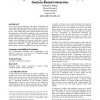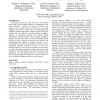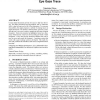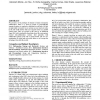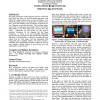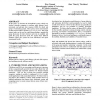ICMI
2004
Springer
14 years 8 months ago
2004
Springer
Perhaps the most fundamental application of affective computing would be Human-Computer Interaction (HCI) in which the computer is able to detect and track the user’s affective ...
ICMI
2004
Springer
14 years 8 months ago
2004
Springer
A novel touch screen technology is presented. TouchLight uses simple image processing techniques to combine the output of two video cameras placed behind a semi-transparent plane ...
ICMI
2004
Springer
14 years 8 months ago
2004
Springer
Understanding human-human interaction is fundamental to the long-term pursuit of powerful and natural multimodal interfaces. Nonverbal communication, including body posture, gestu...
ICMI
2004
Springer
14 years 8 months ago
2004
Springer
This paper discusses the Ohio University Virtual Haptic Back (VHB) project, including objectives, implementation, and initial evaluations. Haptics is the science of human tactile ...
ICMI
2004
Springer
14 years 8 months ago
2004
Springer
Current digital documents provide few traces to help user browsing. This makes document browsing difficult, and we sometimes feel it is hard to keep track of all of the informati...
ICMI
2004
Springer
14 years 8 months ago
2004
Springer
We present a novel paradigm for human to human asymmetric collaboration. There is a need for people at geographically separate locations to seamlessly collaborate in real time as ...
ICMI
2004
Springer
14 years 8 months ago
2004
Springer
In this paper, we describe the concept of a new modality for interaction with digital maps. We propose using inclination as a means for panning maps on a mobile computing device, ...
ICMI
2004
Springer
14 years 8 months ago
2004
Springer
One of the implicit assumptions of multi-modal interfaces is that human-computer interaction is significantly facilitated by providing multiple input and output modalities. Surpri...
ICMI
2004
Springer
14 years 8 months ago
2004
Springer
This paper presents the Visual Touchpad, a low-cost vision-based input device that allows for fluid two-handed interactions with desktop PCs, laptops, public kiosks, or large wall...
ICMI
2004
Springer
14 years 8 months ago
2004
Springer
In this paper, we describe the GroupMedia system, which uses wireless wearable computers to measure audio features, headmovement, and galvanic skin response (GSR) for dyads and gr...

